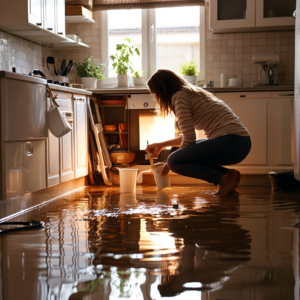HOW TO IDENTIFY AND FIX COMMON LEAKS THAT CAN COST YOU HUNDREDS EVERY YEAR
Hidden Plumbing Leaks: How to Identify and Fix Common Water-Wasting Issues
When most people think of plumbing leaks, they imagine dramatic scenarios like burst pipes flooding their homes or massive water loss causing significant damage. While these situations are certainly serious, they’re not the only types of leaks you need to worry about. In fact, some of the most costly leaks are the ones you don’t even notice at first. Small, hidden leaks can waste hundreds of gallons of water over time, leading to skyrocketing water bills and unnecessary strain on your plumbing system. The good news is that many of these leaks are easy to identify and fix on your own—if you know what to look for. In this article, we’ll explore some of the most common water-wasting culprits and provide step-by-step guidance on how to address them.
The Cost of Ignoring Small Leaks
Before diving into the specifics, it’s important to understand just how much small leaks can cost you. According to the Environmental Protection Agency (EPA), the average household’s leaks can account for nearly 10,000 gallons of wasted water every year. To put that into perspective, that’s enough water to wash 300 loads of laundry! Not only is this a significant waste of a precious resource, but it can also add hundreds of dollars to your annual water bill. By taking the time to identify and fix leaks early, you can save money, conserve water, and prevent more serious plumbing issues down the line.
1. Leaking Faucets: A Drip That Adds Up
One of the most common—and most annoying—types of leaks is a dripping faucet. That constant drip-drip-drip might seem harmless, but over time, it can waste a surprising amount of water. In fact, a faucet that leaks just one drop per second can waste more than 3,000 gallons of water in a year. That’s enough to fill a small swimming pool!
What Causes a Leaking Faucet?
Most faucet leaks are caused by a worn-out rubber washer. The washer is a small component located under the handle that creates a watertight seal when the faucet is turned off. Over time, the washer can become worn, cracked, or misaligned, allowing water to seep through even when the faucet is closed.
How to Fix It:
Fixing a leaking faucet is a relatively simple DIY project. Here’s how to do it:
- Turn Off the Water Supply: Locate the shutoff valve under the sink and turn it clockwise to stop the flow of water. If your sink doesn’t have a shutoff valve, you’ll need to turn off the main water supply to your home.
- Remove the Faucet Handle: Use a screwdriver to remove the handle. Be careful not to damage the finish.
- Replace the Washer: Once the handle is off, you’ll see the washer. Remove it and take it to your local hardware store to find an exact replacement.
- Reassemble the Faucet: Insert the new washer, reattach the handle, and turn the water supply back on.
If the leak persists after replacing the washer, there may be a more serious issue with the faucet, and it might be time to call a professional plumber.
2. Leaking Toilets: Silent but Costly
Toilet leaks are another common source of water waste, and they’re often silent, making them easy to overlook. A leaking toilet can waste hundreds of gallons of water per day, which can quickly add up on your water bill.
How to Detect a Toilet Leak:
Detecting a toilet leak is simple. Here’s a quick test you can do:
- Add Food Coloring: Remove the tank lid and add a few drops of food coloring or a dye tablet to the water in the tank.
- Wait 30 Minutes: Don’t flush the toilet during this time.
- Check the Bowl: After 30 minutes, look in the toilet bowl. If you see colored water, you have a leak.
Common Causes of Toilet Leaks:
- Flapper Valve Issues: The flapper is the rubber valve at the bottom of the tank that lifts when you flush. If it’s worn or cracked, water can leak into the bowl.
- Flush Handle Problems: If the handle sticks or requires jiggling to stop the toilet from running, the issue may be with the handle mechanism.
- Overflow Tube Leaks: If the water level in the tank is too high, it can spill into the overflow tube, causing a constant trickle of water into the bowl.
How to Fix It:
- Replace the Flapper: Turn off the water supply, drain the tank, and replace the flapper with a new one.
- Adjust the Handle Mechanism: Tighten the nut that secures the handle or replace the handle if necessary.
- Adjust the Water Level: If water is spilling into the overflow tube, lower the water level by adjusting the float arm or the fill valve.
3. Flapper Valve Leaks: The Silent Culprit
The flapper valve is one of the most common sources of toilet leaks. Over time, the rubber can degrade, causing it to lose its seal and allow water to flow continuously from the tank into the bowl.
How to Fix It:
Replacing a flapper valve is a straightforward process:
- Turn off the water supply and flush the toilet to drain the tank.
- Remove the old flapper and take it to the hardware store to find a matching replacement.
- Install the new flapper and turn the water supply back on.
4. Overflow Tube Leaks: Adjusting the Water Level
If the water level in your toilet tank is too high, it can spill into the overflow tube, causing a constant leak. This is often due to a misadjusted float arm or fill valve.
How to Fix It:
- Adjust the Float Arm: Gently bend the float arm downward to lower the water level.
- Adjust the Fill Valve: Turn the adjustment screw on the fill valve to lower the water level.
When to Call a Professional
While many minor leaks can be fixed with a little DIY effort, some issues require the expertise of a professional plumber. If you’ve tried the steps above and the leak persists, or if you suspect a more serious problem, it’s time to call in the experts. A professional plumber can perform a thorough leak detection and analysis, ensuring that your plumbing system is in top condition.
Conclusion
Small plumbing leaks might not seem like a big deal, but they can have a significant impact on your water bill and your home’s plumbing system. By learning how to identify and fix common leaks, you can save money, conserve water, and prevent more serious issues down the line. However, if you’re ever in doubt or the problem seems too complex, don’t hesitate to contact a professional plumber. After all, when it comes to your home’s plumbing, it’s always better to be safe than sorry.

